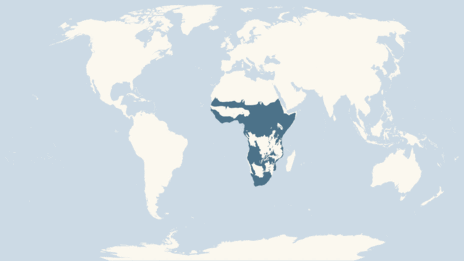 (http://www.arkive.org/african-fish-eagle/haliaeetus-vocifer/)
(http://www.arkive.org/african-fish-eagle/haliaeetus-vocifer/)
- Name: African fish eagle
- Latin: Haliaeetus vocifer
- Classification: Bird
- Origin: Africa
- Lifespan: 25-30 years
- AKA: Fish eagle, river eagle
Taxonomy
- Kingdom: Animalia (Animals)
- Phylum: Chordata (Vertebrates)
- Class: Aves (Birds)
- Order: Falconiformes (Diurnal birds of prey)
- Family: Accipitridae (Hooked Billed)
- Genus: Haliaeetus (Sea eagles)
- Species: Haliaeetus vocifer (African fish eagle)
Appearance
- Height: 73cm (28.7 inches)
- Wingspan: 2m (6ft)
- Weight: 2-2.7kg (4.4-5.9lbs)
The adults have a very distinctive appearance and have a mostly brown body. They have large, powerful black wings and their head, breast and tail are snow white. Their featherless face is bright yellow. Their eyes are dark in colour and their hooked bill is yellow with a black tip. The feet have rough soles and sharp talons, used for catching and holding onto wriggling fish.
The juveniles are brown in colour and tend to have paler eyes than the adults. The females are generally smaller than the males.
Relatives
- Tawny eagle (Aquila rapax) -LEAST CONCERN-
- Black hawk eagle (Spizaetus tyrannus) -LEAST CONCERN-
- Harpy eagle (Harpia harpyja) -NEAR THREATENED-
Habitat & Distribution
These eagles can be found in large numbers around the lakes of South Africa where there is an abundant food supply. A pair may require less than a square mile of water to have enough food, however, if living near a river, they may need up to 15 miles.
The African fish eagle is widespread throughout southern Africa and is particularly common in and around the Rift Valley Lakes.

Diet
Live fish make up about 90% of this birds diet. The rest is made up of other animals including water birds and their young, amphibians and carrion. The birds taken include ibis, storks, herons, spoonbills and the lesser flamingo.
These birds hunt by scanning the water from up in the trees. Once they spot a fish, they swoop down from their perch and snatch it from the water with their talons. The fish is then taken back to the perch to be eaten, or dragged to shore if it is too heavy to carry.
Behaviour
The African fish eagles tend to live in pairs close to streams and lakes. They are active and agile and can perform bold ariel displays, sometimes diving entirely into the water to catch their prey. They can remain on their perch for up to 85-90% of the day.
They are opportunistic feeders and will steal prey from other birds. They are also highly territorial all year round and can be extremely aggressive. They will either chase intruders away or attack from behind.
Reproduction
The breeding season of the African fish eagle is in the dry season, when the water level is low. They are monogamous, meaning they mate for life, and make 2 or more nests which they frequently re-use. They can measure 2m (6 feet) across and 1.2m (4 feet) deep.
The female lays 1-3 eggs which are white with red speckles. The incubation is mainly done by the female but the male will take over while the female hunts. The eggs take around 42-45 days to incubate. The first chick to hatch will often kill its younger siblings. This is known as siblicide and is a behaviour seen in many birds of prey.
Fledging takes 70-75 days and the young can feed itself after 8 weeks. They young birds will leave the nest and establish their own territories after 10 weeks of birth.

Adaptations
- The African fish eagle has a hooked beak which helps it to tear flesh from its prey and pull the strong muscles from its bones.
- This bird of prey also has powerful talons which it uses to grip onto the slippery and wriggling fish it eats.
- The African fish eagles are aggressive birds and will attack each other if they stray into others territory. It has adapted to have feathered legs in order to protect them from the sharp beak of its opponents.
- Like all birds of prey, the African fish eagle has excellent eyesight. It uses this sense of sight to spot fish and other prey from its treetop perch.
Threats
Over fishing is a big threat to this bird as well at the increasing size of the local human populations. Large numbers of people move into the African fish eagle’s territory and fish their food supply dry. The birds then have no option than to leave to other areas to feed.
The biggest threat to these birds however, is pesticides. They enter the water system as run off or ground water from the crops on land and contaminate the water system. This kills huge numbers of fish as well as infecting the birds themselves. These pesticides cause reproductive failure in these animals and thin their eggs shells, making them more receptive to breakages.
Conservation
IUCN Status: Least Concern
This animal is listed as ‘Least Concern’ by the ICUN and there are 300,000 individuals. There are no conservation efforts for the African fish eagle.
Fun Facts
Male: Gigallos
Female: Eagless
Young: Eaglet
Group: Flock
-The young chicks often partake in siblicide. This is where the first chick to hatch will destroy the other eggs, in order to have its parent’s undivided attention.
-African fish eagles are monogamous, meaning they mate for life.

males are Usually smaller then females.
average w of males are 2.0~2.5 but females are w of 3.2~3.6